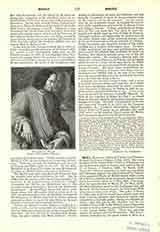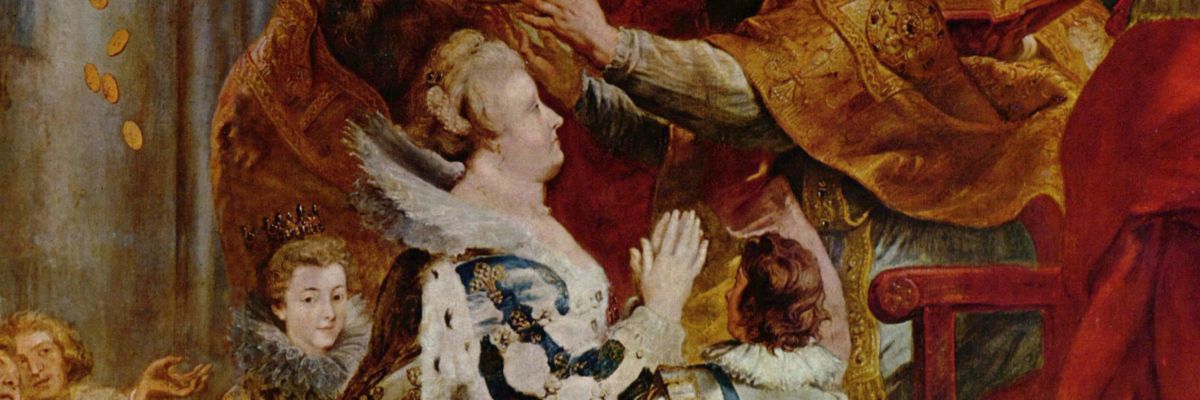

Medici, MARIA DE’, Queen of France; b. at Florence, April 26, 1573; d. at Cologne, July 3, 1642. She was a daughter of the Grand Duke Francis I of Tuscany and the Archduchess Joan of Austria, and married Henry IV of France, October 5, 1600. In March, 1610, Henry IV, who was preparing to lead an expedition into Germany, against the Spaniards and the Imperialists, appointed Maria de’ Medici regent, with a council of fifteen; yielding to her insistence, he also caused her to be crowned queen on May 13, 1610. Two hours after the assassination of Henry IV (May 14, 1610), the Duc d’Epernon went to the Parliament and had Maria de’ Medici declared regent, the little Louis XIII being not yet nine years of age. The policy of Henry IV, who, had he lived, would have striven more and more to secure alliances with Protestant powers, was replaced by a Catholic policy, aiming at a Spanish alliance. The first act in this direction was the betrothal of Louis XIII to the Infanta Anna (afterwards known as Anne of Austria), and of Elizabeth of France to the Infant Philip (1612). There was agitation among the princes and the Protestants. The States-General, convoked by the queen regent in 1614, as a concession to the princes, was the last attempt under the old monarchy to associate representatives of the nation in the national government, and the attempt succeeded ill. Finally, defying the susceptibilities of Conde and the Protestants, Louis XIII married the Infanta Anna on November 28, 1615, and the revolt of the princes, following on the arrest of Conde (September 1, 1616), was the cause of the queen regent’s summoning Richelieu (q.v.), Bishop of Lucon, to her council, as minister of war. Public opinion was aroused by the influence which Maria allowed her lady-in-waiting, Leonora Galigai, and Leonora’s Florentine husband, Concini, Marechal d’Ancre, to obtain over her; Concini was assassinated, April 24, 1617, and thenceforward the influence of Albert de Luynes, a favorite of the young king, predominated. Maria de’ Medici had to leave Paris, May 2, 1617, and it was through the intervention of Richelieu that she was allowed to establish her household at Blois.
The regency of Maria de’ Medici is interesting from the point of view of religious history because of the Gallican agitation which marked it. After the condemnation by the Parliament of Paris of Bellarmine’s treatise on the temporal power of the pope (1610), Edmond Richer, syndic of the faculty of theology, developed, in his “Libellus de Ecclesiastica et Politica Potestate”, the theory that the government of the Church should be aristocratical, not monarchical. Maria de’ Medici decidedly opposed Richer, and, when he had been condemned by an assembly of bishops held at Sens under the presidency of Cardinal du Perron, she had him deposed, and a new syndic elected (1612). When Harlay had resigned the presidency of the Parliament, she refused to appoint in his place de Thou, a Gallican, and appointed instead Nicolas de Verdun, an Ultramontane. In the States-General of 1614, the Third Estate, through its spokesman, Miron, made a declaration of Gallican principles, and tried, with the support of the Protestant Conde, to introduce into its cahier an article on the power of kings, which aimed at the Ultramontanes; Maria de’ Medici ended the business by ordering this article to be taken out of the cahier, and forbidding any further discussion of the question. Another interesting event of this regency was the Assembly of Saumur (1611), in which the Protestants, anxious to preserve and develop the political privileges given them by the Edict of Nantes, set about organizing all over France a vast network of provincial assemblies to watch over the interests of Protestantism, and assemblees de cercles, combining several provinces, which would be able to impose their will on the State. It was thus that, through the initiative of Henri de Rohan, Sully’s son-in-law, there began to form within the French State a sort of separate Protestant party, to which Richelieu was to put an end.
After 1617, Maria de’ Medici lived, with many vicissitudes, a life full of intrigue, which she sometimes carried to conspiracy. Escaping from Blois, February 22, 1619, she made her way into Angouleme and obtained from Luynes the government of Anjou, which became a rallying-point for malcontents. The troops who supported her met those of the king at Les Ponts de Ce and were beaten (August, 1620). On the death of Luynes (December 15, 1621), she regained some of her influence; she caused Richelieu to be admitted to the council (1624), and was even entrusted with the regency during the war in Italy. But as Richelieu’s hostility to Spain became more marked, she sought his dismissal. Allying herself with Gaston d’Orieans, she once—”the Day of the Dupes”, November 12, 1630—thought herself successful in making Louis dismiss the cardinal. She was mistaken. Banished to Compiegne in February, 1631, she vainly endeavored to obtain admission to the stronghold of La Capelle, whence she might have dictated terms to the king. At last she went into exile, to wait for the triumph of Gaston d’Orleans; but Gaston was beaten, and Maria de’ Medici never more set foot in France. From 1631 to 1638 she spent her time in the Low Countries, sending across the French frontier manifestos which no one read. After that, taking refuge in England (1638-41) with her son-in-law Charles I, she was as a Catholic an object of suspicion to the Protestants of that country. Last of all, she betook herself to Germany, where she died, a helpless onlooker at the triumph of that foreign policy of Richelieu which was the exact opposite of what she had followed during her regency. The haughty queen, whose luxury and splendor had been blazoned in Rubens’s immense canvases, possessed but a moderate fortune at the time of her death.
GEORGES GOYAU


